
A revolver is a repeating handgun that has at least one barrel and uses a revolving cylinder containing multiple chambers for firing. Before firing a round, cocking the hammer partially rotates the cylinder, indexing one of the cylinder chambers into alignment with the barrel, allowing the bullet to be fired through the bore. The hammer cocking can be achieved by either the user manually pulling the hammer back, via internal linkage relaying a rearward movement of the trigger, or both. By sequentially rotating through each chamber, the revolver allows the user to fire multiple times until having to reload the gun, unlike older single-shot firearms that had to be reloaded after each shot.
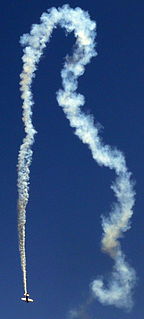
Aerobatics is the practice of flying maneuvers involving aircraft attitudes that are not used in conventional passenger-carrying flights. The term is a blend of "aerial" and "acrobatics". Aerobatics are performed in aeroplanes and gliders for training, recreation, entertainment, and sport. Additionally, some helicopters, such as the MBB Bo 105, are capable of limited aerobatic manoeuvres. An example of a fully aerobatic helicopter, capable of performing loops and rolls, is the Westland Lynx.
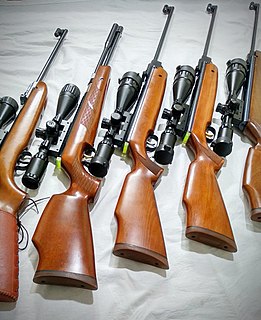
An air gun or airgun is a gun that fires projectiles pneumatically with compressed air or other gases that are mechanically pressurized without involving any chemical reactions, in contrast to a firearm, which pressurizes gases chemically via oxidation of combustible propellants that generates propulsive energy by breaking molecular bonds.

Old North Church, at 193 Salem Street, in the North End, Boston, is the location from which the famous "One if by land, two if by sea" signal is said to have been sent. This phrase is related to Paul Revere's midnight ride of April 18, 1775, which preceded the Battles of Lexington and Concord during the American Revolution.

Timothy Cutler was an American Episcopal clergyman and rector of Yale College.

Jane Gardner Batten, commonly known as Jean Batten, was a New Zealand aviator, making a number of record-breaking solo flights across the world. She is notable for completing the first solo flight from England to New Zealand in 1936.

The Rolls-Royce Thrust Measuring Rig (TMR), was a pioneering vertical take-off and landing (VTOL) aircraft developed by Rolls-Royce in the 1950s. It has the distinction of being "the first jet-lift aircraft to fly anywhere in the world".

A loadmaster is an aircrew member on civilian aircraft or military transport aircraft tasked with the safe loading, transport and unloading of aerial cargoes. Loadmasters serve in the militaries and civilian airlines of many nations.

André-Jacques Garnerin was a French balloonist and the inventor of the frameless parachute. He was appointed Official Aeronaut of France.

Winster is a village in the English Derbyshire Dales about 5 miles (8 km) from Matlock and 6 miles (10 km) from Bakewell at an altitude of approximately 820 feet (250 m). It was formerly a centre for the lead mining industry. The village lies within the Peak District National Park and The Peak District Boundary Walk runs through the village. Winster has many listed buildings, including the Market House open daily as a National Trust information point. Its current population is about 630, though it was 600 at the 2011 Census. The village has a primary school, two churches, two pubs and a village shop which includes a post office. Winster was mentioned in the Domesday Book in 1086 when it was owned by Henry de Ferrers.

Air France Flight 296Q was a chartered flight of a new Airbus A320-111 operated by Air France for Air Charter International. On 26 June 1988, the plane crashed while making a low pass over Mulhouse–Habsheim Airfield as part of the Habsheim Air Show. Most of the crash sequence, which occurred in front of several thousand spectators, was caught on video. The cause of the crash has been the source of major controversy.

Edgar James Kain, DFC was a New Zealand fighter pilot and flying ace who flew in the Royal Air Force (RAF) during the Second World War.

Hot air ballooning is the activity of flying hot air balloons. Attractive aspects of ballooning include the exceptional quiet, the lack of a feeling of movement, and the bird's-eye view. Since the balloon moves with the direction of the winds, the passengers feel absolutely no wind, except for brief periods during the flight when the balloon climbs or descends into air currents of different direction or speed. Hot air ballooning has been recognized by Fédération Aéronautique Internationale (FAI) as the safest air sport in aviation, and fatalities in hot air balloon accidents are rare, according to statistics from the National Transportation Safety Board (NTSB).

The Colt Paterson revolver was the first commercial repeating firearm employing a revolving cylinder with multiple chambers aligned with a single, stationary barrel. Its design was patented by Samuel Colt on February 25, 1836, in the United States, England and France, and it derived its name from being produced in Paterson, New Jersey. Initially this 5 shot revolver was produced in .28 caliber, with a .36 caliber model following a year later. As originally designed and produced, no loading lever was included with the revolver; a user had to partially disassemble the revolver to re-load it. Starting in 1839, however, a reloading lever and a capping window were incorporated into the design, allowing reloading without disassembly. This loading lever and capping window design change was also incorporated after the fact into most Colt Paterson revolvers that had been produced from 1836 until 1839. Unlike later revolvers, a folding trigger was incorporated into the Colt Paterson. The trigger became visible only upon cocking the hammer.
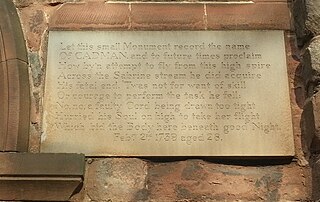
Robert Cadman or Robert Kidman was an 18th-century steeplejack and ropeslider who between 1732 and 1739 performed feats of daring, ultimately by sliding or flying down a rope from St Mary's Church, Shrewsbury to the Gay Meadow across the River Severn.
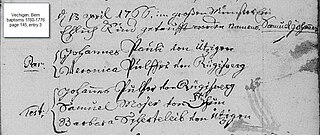
Jean Samuel Pauly, born Samuel Johannes Pauli, was a Swiss inventor and gunsmith of the early 19th century. Parish records show that he was baptised in Vechigen near Bern, Switzerland on 13 April 1766, the son of Johann Pauli and Veronika Christine.

Hovig Demirjian, also known by the mononym Hovig, is an Armenian-Cypriot singer. He represented Cyprus in the Eurovision Song Contest 2017 with the song "Gravity", finishing in 21st place.

Harry Nelson Atwood was an American engineer and inventor known for pioneering work in the early days of aviation, including setting long-distance flying records and delivering the first delivery of air mail in New England.
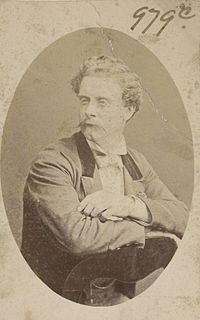
Henri L'Estrange, known as the Australian Blondin, was an Australian successful funambulist and accident prone aeronautical balloonist. Modelling himself on the famous French wire-walker Charles Blondin, L'Estrange performed a number of tightrope walks in the 1870s, culminating in three walks across Sydney's Middle Harbour in 1877. He remains the only tightrope performer ever to have walked across a part of Sydney Harbour. L'Estrange was an early balloonist, and attempted a series of flights in the early 1880s – one being successful, one ending in Australia's first emergency parachute descent, and the last culminating in a massive fireball causing property damage, personal injury and a human stampede. He tried to return to his original career of tightrope walking but, with new forms of entertainment, humiliating falls and other Blondin imitators, he found success elusive. Public benefits were held in his honour to recoup financial losses and he dabbled in setting up amusement rides but ultimately he faded from public attention and was last recorded to be living in Fitzroy, Victoria in 1894.



















